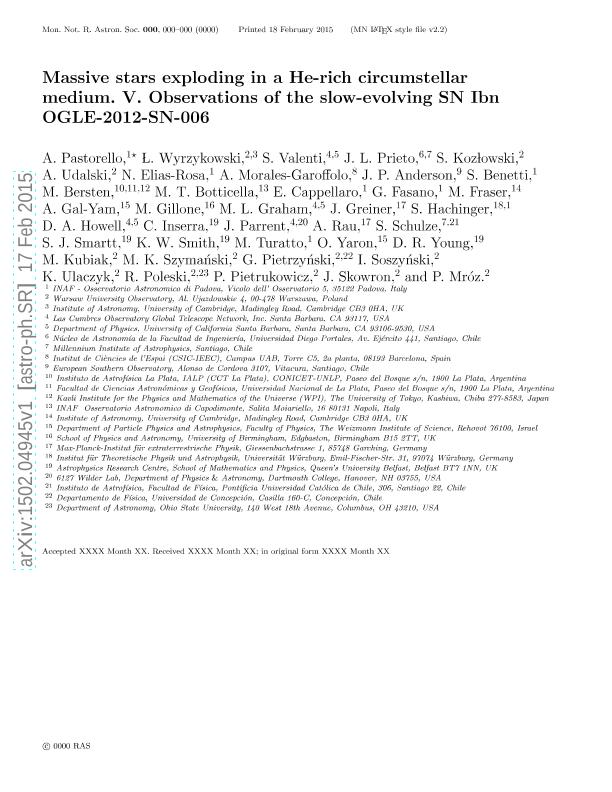Artículo
Massive stars exploding in a He-rich circumstellar medium, V: observations of the slow-evolving SN Ibn OGLE-2012-SN-006
Pastorello, A.; Wyrzykowski, L.; Valenti, S.; Prieto, J. L.; Kozlowski, S.; Udalski, A.; Elias Rosa, N.; Morales Garoffolo, A.; Anderson, J. P.; Benetti, S.; Bersten, Melina Cecilia ; Botticella, M. T.; Cappellaro, E.; Fasano, G.; Fraser, M.; Gal Yam, A.; Gillone, M.; Graham, M. L.; Greiner, J.; Hachinger, S.; Howell, D. A.; Inserra, C.; Parrent, J.; Rau, A.; Schulze, S.; Smartt, S. J.; Smith, K. W.; Turatto, M.; Yaron, O.; Young, D. R.
; Botticella, M. T.; Cappellaro, E.; Fasano, G.; Fraser, M.; Gal Yam, A.; Gillone, M.; Graham, M. L.; Greiner, J.; Hachinger, S.; Howell, D. A.; Inserra, C.; Parrent, J.; Rau, A.; Schulze, S.; Smartt, S. J.; Smith, K. W.; Turatto, M.; Yaron, O.; Young, D. R.
 ; Botticella, M. T.; Cappellaro, E.; Fasano, G.; Fraser, M.; Gal Yam, A.; Gillone, M.; Graham, M. L.; Greiner, J.; Hachinger, S.; Howell, D. A.; Inserra, C.; Parrent, J.; Rau, A.; Schulze, S.; Smartt, S. J.; Smith, K. W.; Turatto, M.; Yaron, O.; Young, D. R.
; Botticella, M. T.; Cappellaro, E.; Fasano, G.; Fraser, M.; Gal Yam, A.; Gillone, M.; Graham, M. L.; Greiner, J.; Hachinger, S.; Howell, D. A.; Inserra, C.; Parrent, J.; Rau, A.; Schulze, S.; Smartt, S. J.; Smith, K. W.; Turatto, M.; Yaron, O.; Young, D. R.
Fecha de publicación:
05/2015
Editorial:
Oxford University Press
Revista:
Monthly Notices Of The Royal Astronomical Society
ISSN:
0035-8711
Idioma:
Inglés
Tipo de recurso:
Artículo publicado
Clasificación temática:
Resumen
We present optical observations of the peculiar Type Ibn supernova (SN Ibn) OGLE-2012-SN-006, discovered and monitored by the Optical Gravitational Lensing Experiment-IV survey, and spectroscopically followed by Public ESO Spectroscopic Survey of Transient Objects (PESSTO) at late phases. Stringent pre-discovery limits constrain the explosion epoch with fair precision to JD = 245 6203.8 ± 4.0. The rise time to the I-band light-curve maximum is about two weeks. The object reaches the peak absolute magnitude MI = −19.65 ± 0.19 on JD = 245 6218.1 ± 1.8. After maximum, the light curve declines for about 25 d with a rate of 4 mag (100 d)−1. The symmetric I-band peak resembles that of canonical Type Ib/c supernovae (SNe), whereas SNe Ibn usually exhibit asymmetric and narrower early-time light curves. Since 25 d past maximum, the light curve flattens with a decline rate slower than that of the 56Co–56Fe decay, although at very late phases it steepens to approach that rate. However, other observables suggest that the match with the 56Co decay rate is a mere coincidence, and the radioactive decay is not the main mechanism powering the light curve of OGLE-2012-SN-006. An early-time spectrum is dominated by a blue continuum, with only a marginal evidence for the presence of He i lines marking this SN type. This spectrum shows broad absorptions bluewards than 5000 Å, likely O ii lines, which are similar to spectral features observed in superluminous SNe at early epochs. The object has been spectroscopically monitored by PESSTO from 90 to 180 d after peak, and these spectra show the typical features observed in a number of SN 2006jc-like events, including a blue spectral energy distribution and prominent and narrow (vFWHM ≈ 1900 km s−1) He i emission lines. This suggests that the ejecta are interacting with He-rich circumstellar material. The detection of broad (104 km s−1) O i and Ca ii features likely produced in the SN ejecta (including the [O i] λλ6300,6364 doublet in the latest spectra) lends support to the interpretation of OGLE-2012-SN-006 as a core-collapse event.
Archivos asociados
Licencia
Identificadores
Colecciones
Articulos(IALP)
Articulos de INST.DE ASTROFISICA LA PLATA
Articulos de INST.DE ASTROFISICA LA PLATA
Citación
Pastorello, A.; Wyrzykowski, L.; Valenti, S.; Prieto, J. L.; Kozlowski, S.; et al.; Massive stars exploding in a He-rich circumstellar medium, V: observations of the slow-evolving SN Ibn OGLE-2012-SN-006; Oxford University Press; Monthly Notices Of The Royal Astronomical Society; 449; 2; 5-2015; 1941-1953
Compartir
Altmétricas



